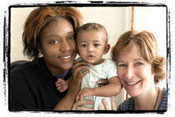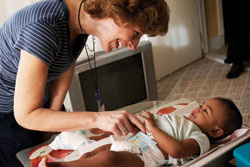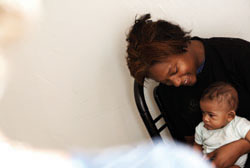Funding Social Programs That Work
It's an idea whose time has come, and TC's Jeanne Brooks-Gunn is a big reason why
Twenty-year-old Nicolette Rutherford was pregnant and living in a shelter in Manhattan with her boyfriend, Jerimy, when Sharon Curley, a nurse home visitor from the Nurse–Family Partnership, met her for the first time. Nicolette and Jerimy had just adopted a kitten.
“They were living in this tiny little room,” Curley recalls, shaking her head and smiling. “I mean, they didn’t even have their own bathroom, and now they take in this little cat and its litter box.”
What a difference a year makes. Today, thanks in large part to Curley’s efforts, Nicolette lives in a new apartment in a bright, clean neighborhood in Queens with her very healthy seven-month-old son, also named Jerimy.
“If it wasn’t for Sharon, I probably would have lost it,” Nicolette says. “It was really hard.”
NFP, which each year nationally helps more than 20,000 new mothers like Nicolette and coaches them on parenting and life skills, is one of many such home visiting programs around the country. The impact of these programs may be about to increase dramatically: In June, Washington state Congressman James McDermott introduced a bill that would increase funding to these efforts by $124 million a year, enabling them to meet the needs of 450,000 families by 2019.
But the even bigger news is that the new money would not be applied indiscriminately. The bill, called the Evidence-Based Home Visitation Act of 2009, seeks to fund home visiting programs that show genuine evidence of success. (That would certainly include NFP, which randomized clinical trials have shown to be superior in reducing preterm births, emergency room use and subsequent births.) Indeed, requiring evidence as a basis for awarding federal funding to social programs and other programs as well is apparently gaining traction across the federal government. In June, in a blog entry titled “Building Rigorous Evidence to Drive Policy,” the Office of Management and Budget (OMB) said that it intends to “put much more emphasis on evidence-based policy decisions” and that the government “should design new initiatives to build vigorous data about what works and then act on evidence that emerges.”
Both the proposal for increased funding for home visiting programs and the broader shift toward evidence-based funding in general owe much to the work of Jeanne Brooks-Gunn, the Virginia and Leonard Marx Professor of Child Development at Teachers College and co-director of the College’s National Center for Children and Families.
For the past 30 years, Brooks-Gunn, a developmental psychologist perhaps best known for documenting the impact of poverty on educational achievement, has conducted landmark, large-scale studies of a range of important social programs. She designed and evaluated the Infant Health and Development Program, the Early Head Start National Evaluation and an early assessment of the Home Instruction for Parents of Preschool Youngsters (HIPPYUSA), another prominent home visiting program then run by TC alumna Miriam Westheimer (at one point, the national office was based at TC in Thorndike Hall). She provided written testimony for the home visitation bill’s initial hearing and spoke at a rollout meeting at the Brookings Institution, attended by McDermott, representatives from OMB and Congressional staffers. And she also advises the Pew Charitable Trust and Doris Duke Charitable Trust on their joint investments in home visiting research.
“People have always wanted to know which programs were effective,” Brooks-Gunn says. “What’s new here is that the Obama administration has mentioned a particular approach, linked to a particular home visiting program that’s effective. At the same time, OMB is really pushing for the use of hard evidence across a variety of programs. And that’s very exciting.”
And also, apparently, badly needed. “Over the past 15 years or so there have been 10 instances in which large federal programs—big funding streams like Head Start and Job Corps—have been rigorously evaluated using random assignment. In nine of those cases, the studies found weak or no positive effects,” says Jon Baron, the founder and president of the Coalition for Evidence-Based Policy, a Washington-based non-profit, nonpartisan organization. “The only exception was Early Head Start where there were some meaningful but modest positive effects. But the other programs, like Job Corps, often were found to produce small effects that faded over time.”
Baron points out that most federal social programs are actually broad funding streams that fund multiple program models and strategies. Although evaluations may show that the program as a whole has little or no positive effect, certain specific models or strategies within the program may indeed be effective.
The new funding focus of the Obama administration is promising, Baron says, because “there’s going to be more interest in developing and expanding evidence-based models and strategies if that is the entrance requirement to get a federal grant award.”
According to Baron, social programs have a long history of getting funded because they fit someone’s preconceived notion of how such a program might work or have the blessing of a key Congressman’s key supporter. Meanwhile, he says, the nation’s poverty rate has increased since 1973 and schools have made limited long-term progress in raising reading, math and science achievement.
“We’ve been doing this for 50 years,” Baron says, “and it’s like Einstein’s definition of insanity: doing the same thing over and over again and hoping for a different result.”
All of this represents good news for organizations that deliver social programs, and for their clients. But there’s one important caveat: It’s how validation is carried out that makes the results meaningful—not just from an informational standpoint, but in terms of what kinds of funding ultimately get enacted.
In a very real sense, the story of home visiting programs offers a stepwise primer for other areas.
Step One might be called “making the case for the category”—which, first and foremost, entails recruiting well-respected, high-caliber social scientists to present the facts. Witness HIPPYUSA, whose research director early on formed an advisory group that included Jeanne Brooks-Gunn.
“Jeanne’s word is a very, very well respected endorsement,” says Miriam Westheimer. “That was partly why we wanted her involved in doing our research. And that was 20 years ago.”
In written testimony she delivered to Congress in June about home visiting programs, Brooks-Gunn (who recently was elected to the prestigious Institute of Medicine of the National Academies) wrote about the effectiveness of the programs in helping young, first-time mothers who had relatively little education and who live in precarious economic circumstances. The children of these mothers are more likely to be the victims of harsh, inconsistent and insensitive parenting, and specifically more likely to be neglected or abused.
“Is it possible to help young mothers improve their educational status and/or parenting capabilities? The answer, from both longitudinal studies and intervention programs is yes,” Brooks-Gunn wrote. “Based on the current literature, young, first-time mothers seem to benefit most from home-visiting programs. Thus targeting this group is a good bet.”
Step Two might be termed “recognizing the variability within the category.” Home visiting programs range widely in approach, method and application, Brooks-Gunn and two co-authors explain in an article they published in the Future of Children Policy Brief Fall 2009. “Some programs already serve thousands of children. Individual programs vary dramatically with respect to children’s age, risk status of families served, range of services offered and intensity of the intervention as measured by the frequency and the duration of the home visiting… Nor do all programs have the same goals. Some aim specifically to reduce child maltreatment, whereas others focus on improving children’s health and developmental outcomes. What they all share is the view that services delivered in a family’s home will have a positive impact on parenting, which in turn can influence the long-term development of the child.”
Step Three is using study results for self-improvement. According to Westheimer, programs like HIPPYUSA emphasize testing not only to ensure they achieve their goals and convince potential backers, but also to keep on getting better. “If you’re doing it right, it should be an ongoing loop of feedback to the program and have direct implications for improvement and development,” she says.
Step Four is to create legislation that perpetuates and broadens the field, based on the best possible criteria. For example, the McDermott bill has been amended to fund programs that don’t have as much evidence behind them but are nevertheless widely considered promising—contingent upon continuing evaluation. These provisions are “a clear sign that both the administration and Congress want to do everything they can to fund successful programs,” Brooks-Gunn has written with co-authors Ron Haskins, a senior fellow and co-director of the Center on Children and Families at the Brookings Institution, and Christina Paxson, dean of Princeton’s Woodrow Wilson School of Public and International Affairs.
Finally, validation through research can also make it easier to replicate a program under different circumstances. For example, New York City’s NFP, currently in its seventh year and serving more than 2,000 families, is now deploying a pilot group of nurses (including Sharon Curley) citywide to deal with particularly acute cases. The members of this special team carry a significantly lower caseload than their colleagues. Though relatively new, the overall program, overseen by the New York Department of Health and Mental Hygiene, already is showing positive results in increasing breastfeeding initiation and duration, immunization rates, birth spacing and workforce participation.
“Essentially, we’re anticipating birth with a family that might be totally unprepared to step into a new parenting role,” says the program’s director, Lisa Landau. “We’re targeting parents who themselves might not be from a family where nurturing and good parenting was part of the pattern, and we’re trying to reinforce positive bonding and attachment between the parents and the child.”
Not every client becomes a success. Sharon Curley counsels a mother who is 14 and is on her second baby, and another whom she had to refer to the Administration of Child Services on suspicion of child abuse—a rarity for NFP. “It breaks your heart,” she says. “You build this relationship for a year and a half, but you’ve got to do what you’ve got to do.”
But the tale of Nicolette Rutherford seems promising. Bright and eager to learn, she is guilty mainly of a sometimes unrealistic penchant for taking care of others. As part of the NFP curriculum, Curley and Nicolette have discussed family planning, which has inspired Nicolette to take a break before having another baby. And recently Curley and Nicolette discussed the challenges Nicolette would face if, as she was thinking about doing, she started her own help hotline.
“I said, ‘All right let’s think about this,’” Curley recalls. “‘The phone will be ringing at three in the morning, and somebody’s telling you they’re on the top of a roof. What would be your plan? What are you going to do?’”
Ultimately, Curley encouraged Rutherford to think about a more practical way of helping people: Going back to school to earn a degree as a social worker—or maybe even a nurse.
Published Thursday, Apr. 1, 2010





